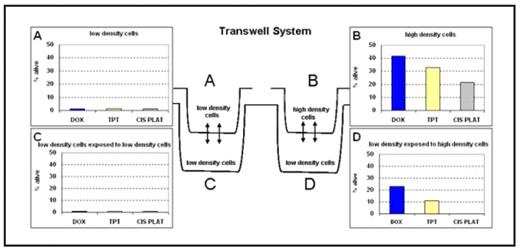Abstract
Drug resistance continues to be a major obstacle in the treatment of multiple myeloma. Data have shown that the bone marrow microenvironment plays an important role in drug resistance. Whether it is mediated through the physical interaction of stromal and tumor cells or by soluble factors, this communication is essential for survival by both normal and tumor cells. In the current study we use a transwell system to allow passage of soluble factors from high density (drug resistant) to low density (drug sensitive) human myeloma 8226 cells. In our model, 8226 cells translocate topoisomerase IIa (topo IIa) from the nucleus to the cytoplasm when at high density (3 × 106 cells/ml) for 16 hours, rendering the cells 38-fold resistant to doxorubicin (DOX), a topo II poison, relative to low density cells (see column 1 in graph A & B below). When low density (2 × 105 cells/ml) cells are separated from the high density cells by a 3.0 micron porous membrane for 16 hrs, we observed a 14-fold increase in resistance in the sensitive cells after a 1 hr exposure to DOX as compared to cells exposed to low density cells (see column 1 in graph C & D). Moreover, this increased resistance was less pronounced (2.5 fold) with topotecan (TPT), a topo I inhibitor, and no effect was seen when cis-platinum (CIS PLAT), a non-topo drug, was used in this system (see columns 2 & 3 in graph C & D), suggesting that topo IIa may be the specific target. This mechanism also appears to be time-driven, as the resistance increases over time in the sensitive cells during the course of the 16 hr exposure. In addition, drug resistance to DOX was observed when the sensitive cells were exposed to only “conditioned” media, but no effect was seen when exposed to high density cells in fresh media, suggesting that soluble factors are released from drug resistant cells into the microenvironment causing drug sensitive cells to acquire an increased ability to evade programmed cell death.
Disclosures: No relevant conflicts of interest to declare.
Author notes
Corresponding author


This feature is available to Subscribers Only
Sign In or Create an Account Close Modal